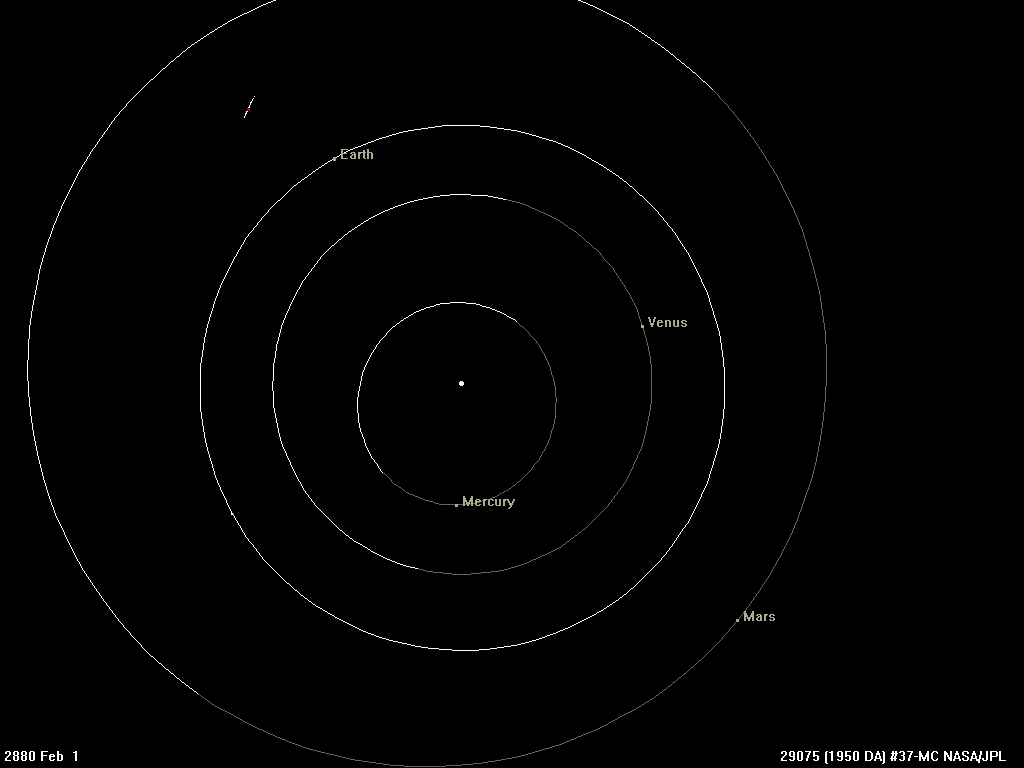If an asteroid crashes into the Earth, it is likely to splash down somewhere in the oceans.
A computer simulation of an asteroid impact tsunami shows waves as high as 400 feet sweeping onto the Atlantic Coast of the United States and inundating heavily populated coastal areas.
The research is based on a real, two-thirds of a mile in diameter asteroid, 1950 DA, known to be on course for a close encounter with Earth eight centuries from now.
On March 16, 2880, this huge rock is due to swing so close to Earth it could slam into the Atlantic Ocean at 38,000 miles per hour.
Although the probability of an impact from 1950 DA is only about 0.3 percent, it is the only asteroid yet detected that scientists cannot entirely dismiss as a threat. A team of scientists led by researchers at NASA’s Jet Propulsion Laboratory reported on the probability of 1950 DA crossing paths with the Earth in the Atlantic Ocean about 360 miles from the U.S. coast.

Although the probability of a direct hit is pretty small, asteroids this size and larger have periodically hammered the planet, sometimes with calamitous effects. The so-called K/T impact, for example, ended the age of the dinosaurs 65 million years ago.
And from a geologic perspective, events like this have happened many times in the past. Asteroids the size of 1950 DA have probably struck the Earth about 600 times since the age of the dinosaurs.
It is estimated that if 1950 DA were to collide with the planet, it would do so with an force of around 44,800 megatonnes of TNT. Although the probability of an impact is only 0.3 per cent, this represents a risk 50 per cent greater than an impact from all other asteroids.

The catastrophe’s summary
The 60,000-megaton blast of the impact vaporizes the asteroid and blows a cavity in the ocean 11 miles across and all the way down to the seafloor, which is about 3 miles deep at that point. The blast even excavates some of the seafloor. Water then rushes back in to fill the cavity, and a ring of waves spreads out in all directions. The impact creates tsunami waves of all frequencies and wavelengths, with a peak wavelength about the same as the diameter of the cavity. Because lower-frequency waves travel faster than waves with higher frequencies, the initial impulse spreads out into a series of waves.

The waves propagate all through the Atlantic Ocean and the Caribbean. The waves decay as they travel, so coastal areas closest to the impact get hit by the largest waves. Two hours after impact, 400-foot waves reach beaches from Cape Cod to Cape Hatteras, and by four hours after impact the entire East Coast has experienced waves at least 200 feet high. It takes 8 hours for the waves to reach Europe, where they come ashore at heights of about 30 to 50 feet.
Rogue comets visiting the inner solar system for the first time, however, may never be detected very long in advance. Smaller asteroids that can still cause major tsunami damage may also go undetected.
Those are risks we may just have to live with.












[…] STRANGE SOUNDS REPORT HERE […]